Customer Journey Maps are a visual story about how people interact with your brand. They help you gain a deeper understanding of your customers, and act as a bridge between business and buyers.
Journey Mapping has its roots in design but since it's become mainstream, the number of design approaches has exploded. Hundreds of consultants have put their own spin on the look of a journey map - i can feel overwhelming if you're new to journey mapping, or just want to see what your options might be.
In this post we'll cover:
- 6 customer journey maps examples
- Analysis on what is and isn't working in these customer journey maps
- My professional opinion on what might make these journey maps work harder
- Free resources and downloads to learn more about customer journey mapping
Journey Map Example #1: Ordering a Cake
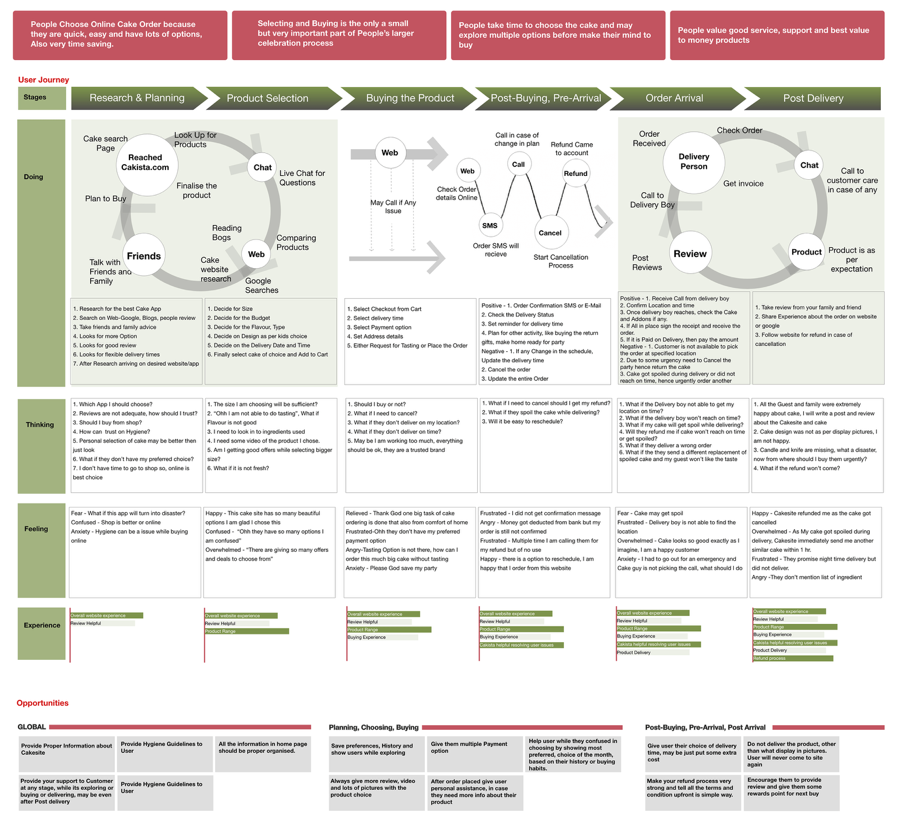
Why I love this journey map example:
- This map does have a really interesting visual take on combining touchpoints and the purchase journey (see the section called "Doing"). Usually you won’t see touchpoints be the first thing under the stages of the purchase journey. But this map makes the “doing” feel like it’s the most important bit.
What I might change:
- I do feel like this map would benefit from a more obvious emotional journey — to me, I’m not sure the bar system is communicating the emotional dimension.
- This map is also missing a key section — the Persona.
Journey Map Example #2: Student Application
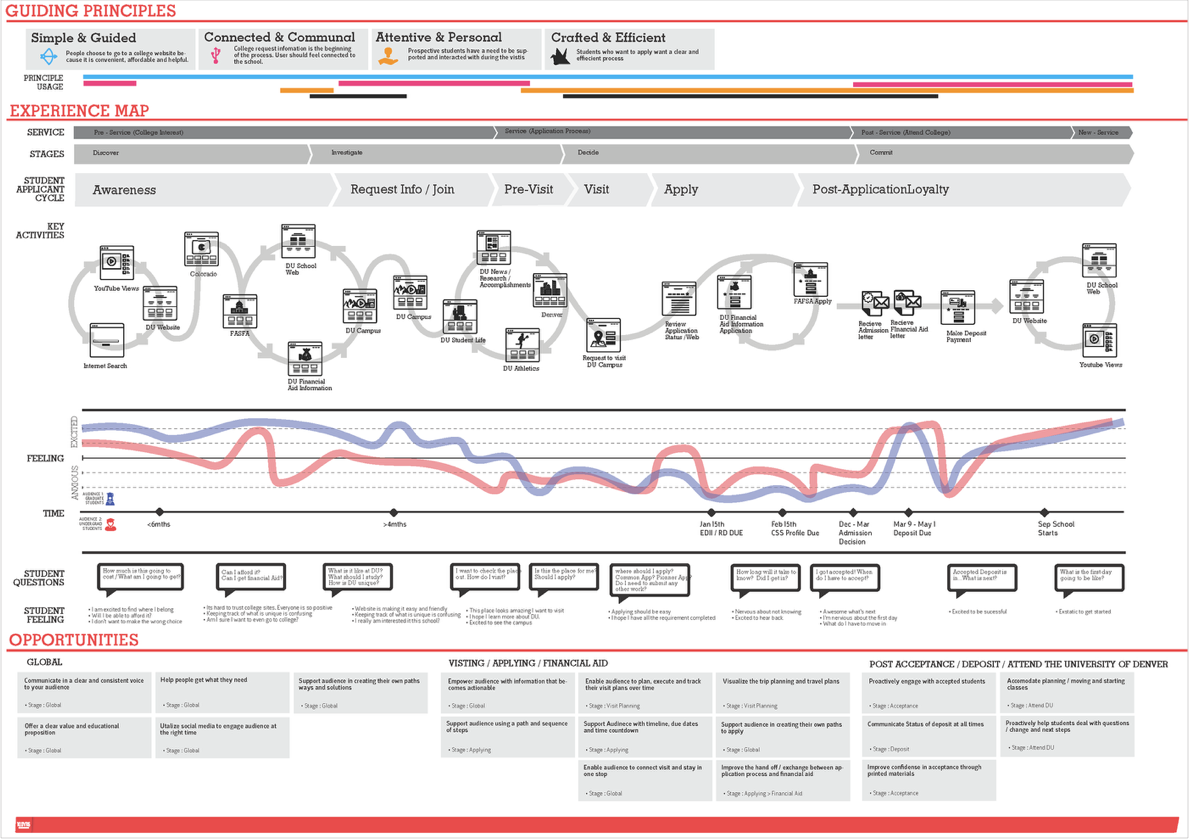
Why I love this journey map example:
- This map does a great job of bringing vast amounts of information together in a single map (although one might argue, this is too much information to include in a single map).
What I might change:
- This map does a great job of combining multiple personas into a single map — however, I recommend against this approach as it can confuse stakeholders, and make it harder to extract insight from the Journey Map.
Journey Map Example #3: Dating App
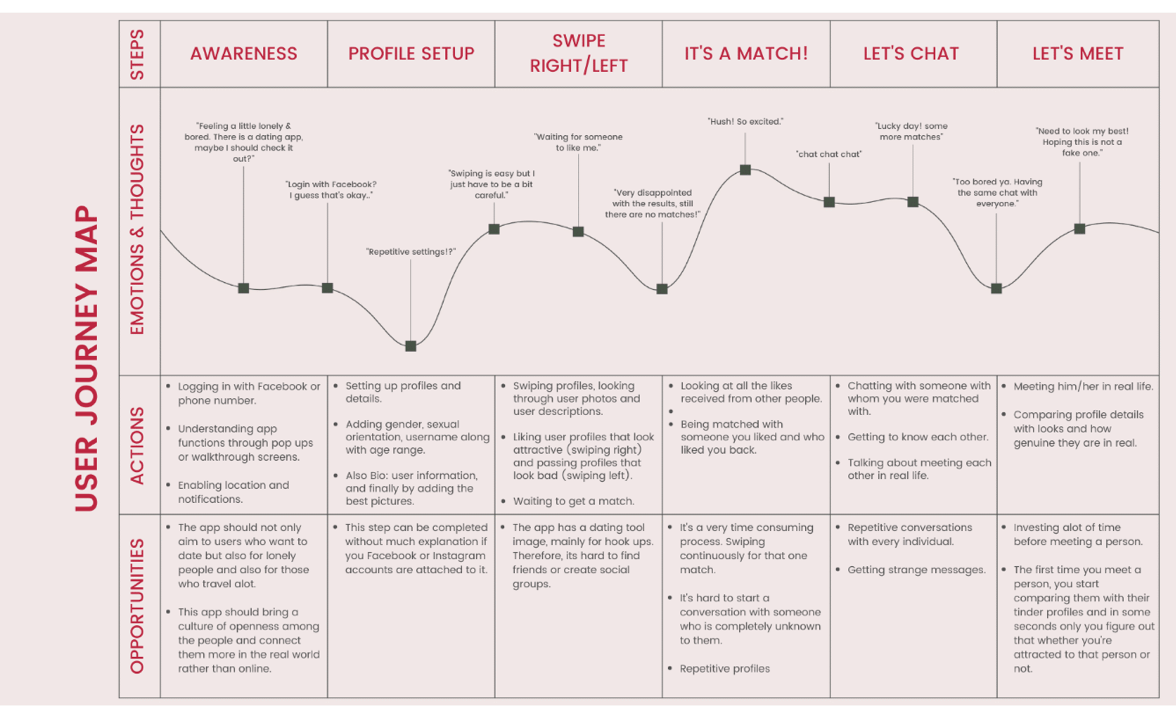
Why I love this journey map:
- This journey map ticks all the boxes for a good, basic map. It’s also an interesting “purchase” journey that could lead to exciting opportunities to innovate.
What I might change:
- This map would benefit from some “real life” photos of the UX and in-real-life process. Integrating photographs is a great way to bring a journey to life (but no stock photos, please!).
- This map will also be made more robust with a visualization of the emotional journey — the ups and downs are evident, but what type of emotion is down? Is it angry, sad, depressed, or anxious? These variations in sentiment help paint an empathetic picture of our customers.
🚀 Learn what makes buyers tick
Join 8k+ of world's best marketers from brands like Disney, Coca-Cola, Google who are learning marketing psychology in <5 mins a week.
Journey Map Example #4: Office Action
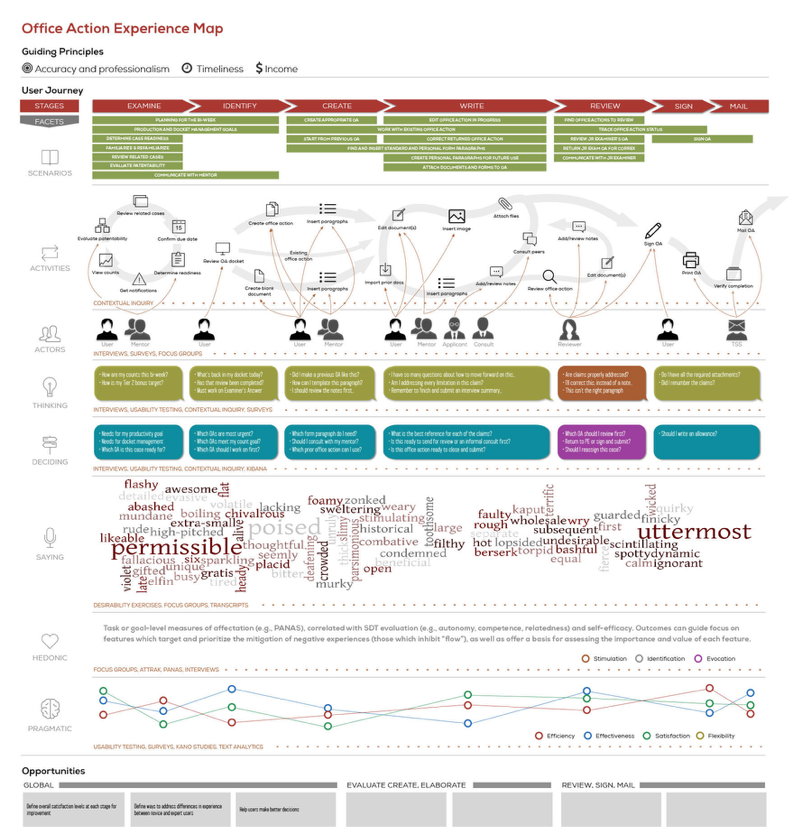
Why I love this journey map:
- This journey map includes some exciting elements, such as the Word Cloud (under “Saying”) of customer quotes.
What I might change:
- Depending on the audience, there’s almost too much information on this journey map. I’d consider the ultimate purpose of the “Hedonic” and “Pragmatic” sections, as well as brainstorming a different way to show the “Actors” section, and it makes the map look cluttered. Too much information can undermine the use of a Journey Map as a communication tool.
Journey Map Example #5
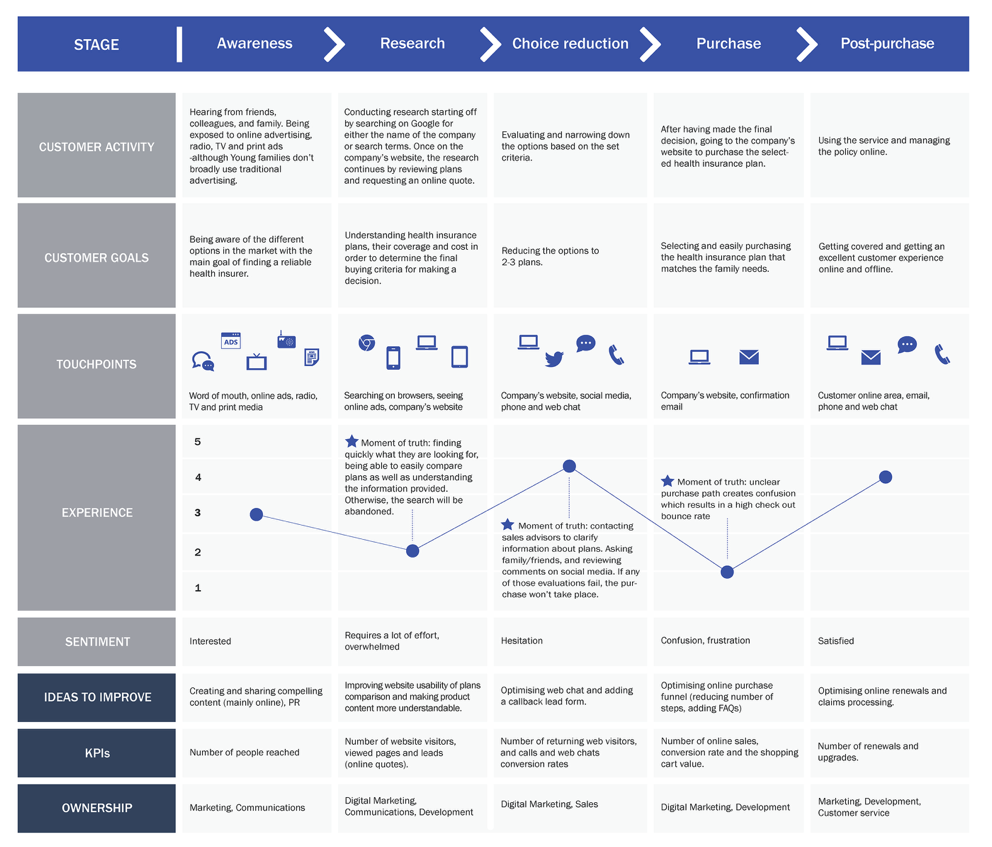
Why I love this journey map example:
- This map has a section for KPIs and Ownership which is unique. That means it will make the next steps easier. Although I do recommend including these sections as a follow-up workstream, I don’t often include them on the map because people can get hung up on them and ignore the information on the map.
What I might change:
- This has all the parts of a strong journey map, but it’s not very visually engaging. I’d send it back through design to incorporate some more interesting visual elements (esp. around touchpoints and the emotional journey and “Experience” sections).
- I’d include a summary of the Persona on this map so that in case it gets sent around the company without the matching Persona, it’s still easy to understand.
Journey Map Example #6: Healthy Eating
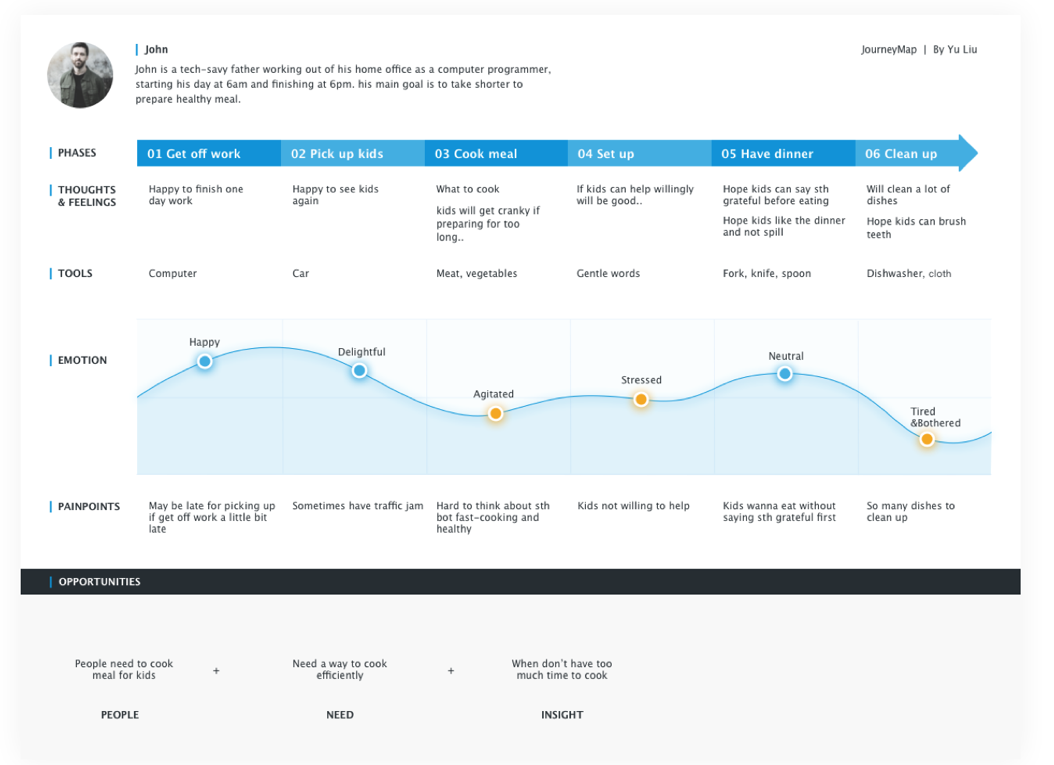
Why I love this journey map:
I like the thought of calling touchpoints “tools” — this language could be useful when talking to customers or non-design or marketing audiences.
What I might change:
I do like that this map has included a formula for opportunities (People + Need + Insight). I’d love to apply that to a future map. However, I do think these opportunities could be matched to pain points more closely. They should also consider naming more specific solves rather than framing the opportunity so broadly.
The Bottom Line
As you can see from the journey maps in this article, there’s no one “right way” to create a map. Instead, you’ll need to decide how best to design your journey map for your specific audience.
Think carefully about how you’ll use your map as a tool for communication.
Ask yourself:
- Is it immediately clear which points are my key insights and moments of truth?
- Is my map easy to scan and understand? Or will people feel overwhelmed when they first see it?
- How will my map be presented to stakeholders (for example, printed, emailed, put on an internal webpage or presentation), and does that influence my design in any way?
Customer Journey Map Image Sources: Himani Agarwal; Source: Christopher Becker; Source: khushi Singh; Source: Michael Moretti; Source: Olga Casablancas; Source: Kiki Liu
Get Free Journey Mapping Resources👇
- Sign up to attend a free 60-minute workshop on April 19th, where we'll work together to build a Customer Journey Map.
- Download "From Behavior to Business Growth: An Introduction to Behavioral Personas"
- Swipe files & Analysis of 20 Customer Journey Maps: Use this free download to gather ideas and inspiration for the format and design of your customer journey map (a very important part of the process).
- Explosive Growth: 10 Ways Journey Maps Can Boost Your Business
- Get a free Customer Journey Map template here.
Keep Learning:
- 3 Ways to Apply Behavioral Science to Customer Journey Maps
- 6 Essential Parts of a Customer Journey Map
- Customer Experience Measurement: How to use metrics in your customer journey map
Learn Journey Mapping the easy way:
- Register interest for one of my most popular courses, "How to Create Magnificent Journey Maps."
